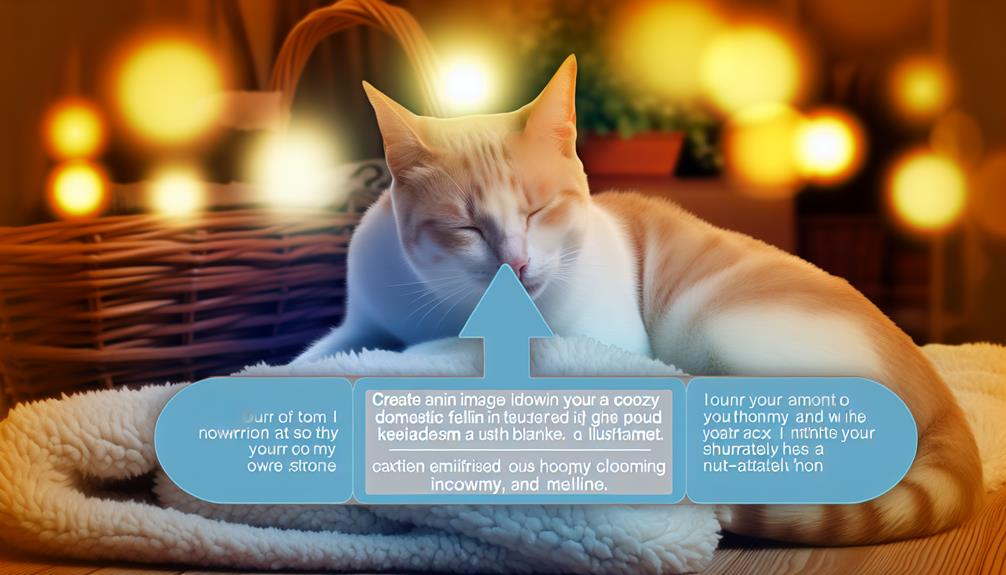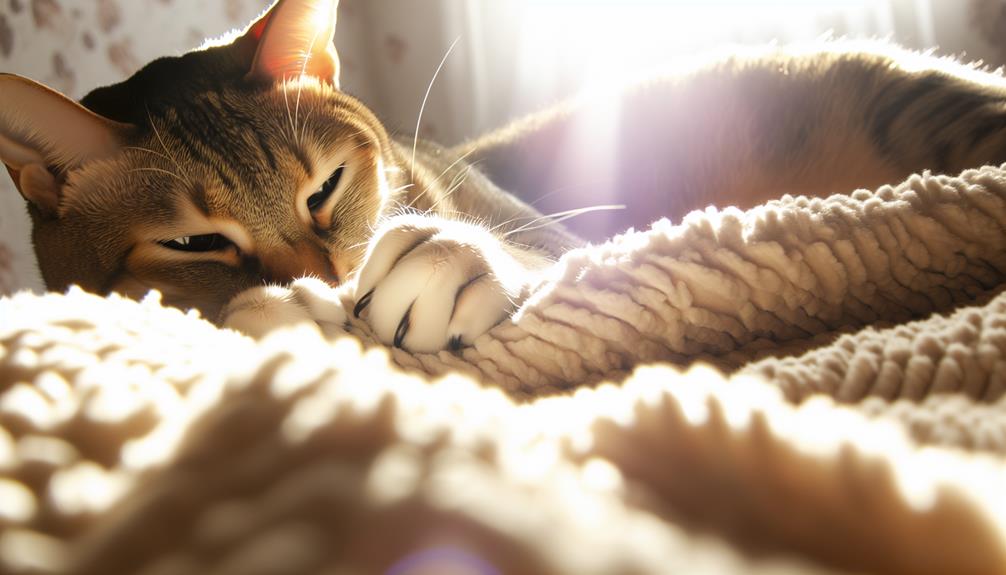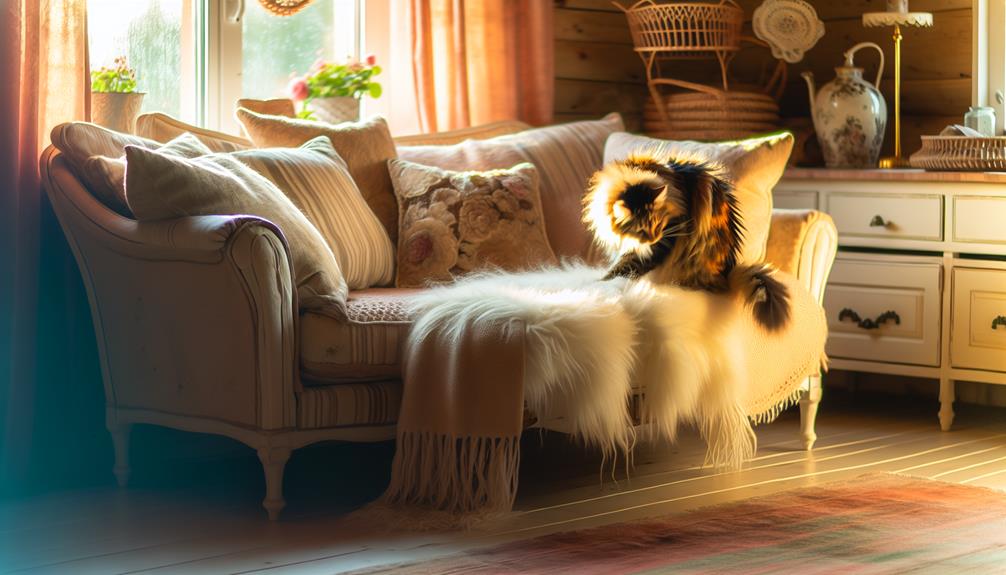Imagine your cat's paws rhythmically pressing into a soft blanket, each motion deliberate and gentle. You might wonder why they engage in this peculiar behavior, often referred to as kneading. It's not just a quirky habit; it's deeply rooted in their instincts from kittenhood. While it seems endearing, kneading serves multiple purposes, from marking their territory to seeking comfort and security. This simple action tells you a lot about your feline friend's emotions and physical needs. Curious to understand the full significance behind these tender pushes? Let's explore further.
Instincts From Kittenhood
From the earliest days of their lives, kittens exhibit a fascinating behavior known as kneading, where they rhythmically push their paws against soft surfaces. This action is not merely random; it serves specific purposes rooted in their early development and maternal behavior. When kittens are nursing, they knead their mother's mammary glands, which stimulates milk flow, ensuring they receive adequate nutrition. This primary function of kitten kneading is critical for their survival during those initial weeks of life.
You'll notice that this behavior doesn't vanish as the kitten matures. Instead, it persists into adulthood, often observed when cats are in a relaxed state, such as before sleep or while being petted. The continuation of kneading into adulthood can be attributed to its association with the comfort and security experienced during nursing. The rhythmic motion and the tactile sensation of a soft surface might evoke the warmth and safety provided by the mother.
Furthermore, kneading can be linked to the strong bond formed between the kitten and its mother. This maternal behavior reinforces a sense of trust and well-being. As a result, when adult cats knead, they're likely reliving those comforting memories. The action of pushing their paws against soft surfaces becomes a self-soothing mechanism, effectively reducing stress and promoting relaxation.
Marking Their Territory
Beyond the comforting memories of kittenhood, there's another intriguing reason why adult cats knead: marking their territory. This behavior is not merely a vestige of their early life but also a sophisticated method of communication involving scent glands located in their paws. When a cat rhythmically pushes its paws onto a surface, it simultaneously releases pheromones from these scent glands. These chemical signals play a significant role in feline social behavior.
From a scientific perspective, this territorial marking serves multiple purposes. First, it establishes a cat's presence within a particular area. The deposited scent acts as a marker that other cats can detect, thereby delineating boundaries and reducing potential conflicts. Fundamentally, the act of kneading allows the cat to create a chemical signature that says, "This area is claimed."
Moreover, the scent marking extends beyond mere territoriality. It functions as a social cue, providing other cats with information about the individual who left the mark. Factors such as the cat's identity, reproductive status, and even emotional state can be conveyed through these pheromonal messages. This form of communication is particularly essential in multi-cat environments where direct interactions might be limited or fraught with tension.
Understanding this behavior from a clinical perspective can enhance the human-feline relationship. Recognizing that kneading is a key aspect of your cat's social behavior underscores the importance of respecting their need to mark territory. Ignoring or discouraging this natural activity could inadvertently contribute to stress or behavioral issues. Consequently, kneading is not just a comforting action but a complex, instinctual practice with significant implications for a cat's social dynamics and well-being.
Comfort and Security

The act of kneading also serves as a mechanism for comfort and security. When your cat pushes its paws rhythmically, it's not just engaging in a harmless habit; it's creating a sense of well-being. This behavior is often accompanied by purring sounds, which further indicate a state of relaxation and contentment. Purring is a low-frequency vibration that has been shown to have a calming effect not only on the cat but also on other animals and humans in its vicinity.
Cats often knead in locations they deem as safe spaces. These are areas where they feel secure and protected from potential threats. By kneading, cats effectively create a microenvironment that reinforces their sense of safety. The repetitive motion, combined with the presence of familiar scents and textures, helps them to establish a zone of comfort. This behavior can be traced back to kittenhood when they knead their mother's belly to stimulate milk flow, associating the action with nourishment and security.
Additionally, kneading is often observed in cats before they settle down to sleep. This is a preparatory behavior aimed at creating a soft, comfortable surface to rest upon. The act of pushing against a surface with their paws can also be seen as a way to test the safety and stability of their chosen resting spot. Essentially, kneading is a complex behavior that serves multiple functions, all contributing to the cat's overall sense of comfort and security. It's a clear indicator that your feline finds the environment reassuring and conducive to relaxation.
Stretching and Exercise
Cats' kneading behavior also serves as a form of stretching and exercise. When your cat engages in paws kneading, it's not just a random act but a deliberate physical activity aimed at maintaining flexibility and strength. This behavior involves extending and retracting their claws while pressing down into a soft surface, which effectively stretches the muscles in their paws, forelimbs, and shoulders. Such repetitive motions contribute to muscle conditioning and joint health, ensuring they stay agile and ready for sudden movements or jumps.
In terms of feline behavior, this practice is essential for their overall physical well-being. Just as humans need regular exercise to keep their muscles toned, cats use kneading to stretch their limbs and maintain muscle elasticity. It's particularly important for indoor cats, who might not get as much physical activity as their outdoor counterparts. By engaging in kneading, they can replicate some of the stretching they would naturally perform in the wild. This behavior also helps in keeping their claws sharp and in prime condition, which is critical for both hunting and self-defense.
Furthermore, paws kneading can stimulate blood circulation within the limbs, enhancing nutrient delivery to muscle tissues and promoting overall limb health. This activity is a natural and instinctive behavior embedded in their daily routines. Observing your cat's kneading can provide insights into their physical health and activity levels. Consequently, while it may seem like a simple, even endearing action, kneading serves a significant function in your cat's physical maintenance and overall well-being.
Sign of Affection

While stretching and exercise are fundamental aspects of kneading, this behavior also serves as a profound sign of affection. When your cat engages in kneading, it often coincides with purring behavior, indicating a state of contentment and comfort. The rhythmic motion of pushing their paws against a surface, such as your lap, can be viewed as a form of social bonding, rooted in early kittenhood when they kneaded their mother's belly to stimulate milk flow.
From a scientific perspective, kneading activates the release of endorphins, which contribute to a sense of well-being in your feline companion. This act is not merely a remnant of kitten behavior, but an evolved mechanism to express trust and attachment. When your cat kneads on you, it's fundamentally marking you as a safe and cherished part of its social group. The presence of scent glands in their paws further bolsters this notion, as they leave behind subtle olfactory markers during the kneading process.
In addition, the presence of purring behavior during kneading strengthens the argument for its role in social bonding. Purring releases vibrations that are soothing both to the cat and to the recipient of its affection, reinforcing a mutual connection. This behavior serves a dual purpose: it's a self-soothing mechanism for the cat and a clear signal of its affection towards you.
Understanding the multifaceted reasons behind kneading can enhance your appreciation of this behavior. Recognizing it as an affectionate gesture can deepen the bond you share with your feline, transforming a simple act into a profound expression of love and trust.
Conclusion
Imagine your cat kneading your lap as a pianist performing a delicate melody. This instinctual behavior, deeply rooted in their kittenhood, isn't just about comfort and security; it's also their way of marking territory and ensuring physical well-being. When your feline friend pushes with their paws, they are expressing affection and reinforcing your bond. So next time you feel those rhythmic presses, know it's a symphony of trust, love, and instinctual needs being met.
